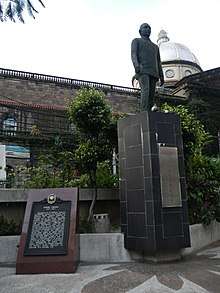Román Ongpin
Román Ongpin was a Filipino-Chinese businessman and philanthropist who aided Filipino revolutionaries against the Spanish and American colonial administration in the Philippine islands.[1]
Román Ongpin | |
|---|---|
 | |
| Born | February 28, 1847 |
| Died | December 10, 1912 (aged 65) |
| Resting place | Manila North Cemetery |
| Occupation | Businessman, philanthropist |
| Spouse(s) | Pascuala Domingo |
Early life
Ongpin was born in Binondo, Manila on February 28, 1847[1] to Simon Ongpin and Sinfrosa Tanbensiang. His father Simon Ongpin (Chinese: 王翼彬; pinyin: Wáng Yìbīn; Pe̍h-ōe-jī: Ông Ia̍k-pin; hispanized as "Ongpinco" (Chinese: 王彬哥; Pe̍h-ōe-jī: Ông-pin-ko, later shortened to become "Ongpin" (Chinese: 王彬; Pe̍h-ōe-jī: Ông-pin))[2] is among those who migrated from mainland China to do business in the Philippine islands. Ongpin learned about doing business at a young age.[3]
Career
Ongpin established his own business in 1883 he dubbed as "El 82" after the cholera outbreak in the Philippine islands a year before. The name was chosen as a symbol of rebirth of the archipelago from the health disaster. The business of Ongpin was a success, and his wealth and social standing improved. He pioneered the use of fixed pricing and double-entry accounting system. One of the exclusive products that El 82 sold was art supplies. Ongpin's wife Pascuala Domingo was a descendant of Filipino artist Damián Domingo. Through this, Ongpin got involved with the illustrados.[4]
Ongpin is a financier of the Katipunan,[4] letting the revolutionaries use his store as a secret hideout. Ongpin also provided financial aid and food to the revolutionary movement until the end of the Spanish colonization of the Philippines. Ongpin once again aided the Filipinos following the Philippine-American War and was imprisoned by the Americans from December 1900 until March 1901.[3]
Despite attaining freedom from imprisonment, Ongpin remained opposed against the United States' occupation of the Philippines. He expressed this sentiment by refusing to sell his products to Americans and teaching his children to be self-sufficient without help from foreigners.[3]
Ongpin also had civic involvements and held posts in organizations. He was the Teniente Primo de Mestizos, president of Casa Asilo de Invalidos Filipinos de Guerra an institution for veterans of Pascual Poblete, and treasurer of Union Obrera de Filipinas of Isabelo de los Reyes. He also had membership at the Philippine Chamber of Commerce.[3]
Death and legacy
Ongpin died on December 10, 1912,[1] due to heart ailment. Before his death, he requested his family to dress his corpse with barong tagalog.[3] He was interred at the North Cemetery of Manila.[1]
The Calle Sacristia in Manila was renamed as Ongpin Street on September 17, 1915 and a monument of Ongpin was built near the Binondo Church and the Plaza de Binondo (now Plaza San Lorenzo Ruiz).[1]
References
- Medina, Marielle (27 February 2015). "Did you know: Roman Ongpin". Philippine Daily Inquirer. Inquirer Research. Retrieved 6 June 2016.
- Toward a History of Chinese Burial Grounds in Manila during the Spanish Colonial Period
- Jimenez, Fidel (4 December 2010). "Sino si Ongpin ng Binondo?" [Who is Ongpin of Binondo?] (in Filipino). GMA News. Retrieved 6 June 2016.
- Suryadinata, Leo, ed. (2012). Southeast Asian Personalities of Chinese Descent: A Biographical Dictionary, Volume I & II. Institute of Southeast Asian Studies. pp. 853–854. ISBN 9789814345217. Retrieved 6 June 2016.